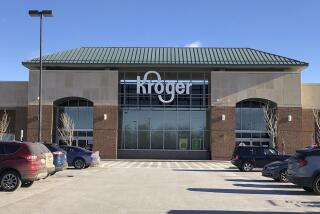Spain’s ‘Hypermarkets’ Buy Small to Grow More
- Share via
MADRID — Marisefa Munoz used to drive to the outskirts of Madrid to shop at a hipermercardo, a warehouse-size store crammed with groceries, clothing, stereo equipment and car parts.
But the 40-year-old publicist wearied of the traffic jams and switched to shopping at her local discount supermarket. She said she likes the personal attention and thinks the quality of goods at the store, which stocks mainly groceries and a few household items, is better.
“In hypermarkets, the produce is already wrapped up and you can’t select what you want,” said Munoz one recent afternoon as she walked home from a shopping trip.
Munoz is not alone in her preferences. After years of grabbing market share from neighborhood markets, hypermarkets have seen it erode as thousands of Spaniards find they’d rather shop closer to home, particularly at discount markets that aggressively mark down prices. So in recent months, the hypermarkets have been conducting a shopping spree of their own.
Centros Comerciales Continente SA, or Continente, said this fall that it plans to buy Spain’s 15th-biggest food retailer, Simago SA, for at least $105 million from Hong Kong’s Dairy Farm International Holdings Ltd. Analysts said that’s spurred Pryca, or Centros Comerciales Pryca SA, Spain’s largest hypermarket operator, into hunting for an acquisition.
“As consumer confidence rises, people aren’t as worried about saving that last penny,” said Javier Valverde, a retail analyst at Santander Investment in Madrid. “They look less at saving and more at convenience, and it may be more convenient to shop at the store down the street than to leave town.”
Their shifting preferences are showing up in sales at Spain’s biggest stores, which include hypermarkets. Sales fell 1.9% in September from August and rose only 3.1% in the year, according to the National Statistics Institute. That compares with an 8.5% rise in total retail sales in the month, and 4.3% from a year earlier.
According to the most recent figures available from the Industry Ministry, sales at Spain’s 10 biggest supermarket chains rose 6% to 23% from 1994 to 1995. During that same period, sales at the three largest hypermarket chains grew 4.2% to 5.5%.
Government regulations that restrict new openings of hypermarkets, store hours and Sunday openings have contributed to some of their sales doldrums.
“Everything’s gone bad [for hypermarkets] since the government regulations,” said Simon Raggett, an analyst at Williams de Broe. “Continente and Pryca are two of the most disappointing stocks I’ve come across.”
Raggett has a “reduce” recommendation on Pryca and a “sell” on Continente.
Shares in Pryca have fallen 15.8% this year, making it the second-worst performer on the IBEX 35 Index, which has risen 26% this year. Continente has fared better, but not by much: It has risen 7.9%.
Sales for Pryca, which is 64% owned by France’s Carrefour SA, said yesterday that profit in the first nine months fell 15% because of weak consumer demand and one-time costs.
Continente’s nine-month profit dropped 9.4% to 5.86 billion pesetas ($40 million), on increased taxes. Buying the loss-making Simago will keep its profit growth in single digits for two years, Valverde said.
The purchase will be Continente’s first venture into smaller-scale retailing. Its largest shareholder, France’s Promodes SA, owns 65% of Dia, Spain’s largest chain of so-called discount supermarkets, which offer lower prices than the hypermarkets, house brands and no-frills service.
“Pryca and Continente sales have been poor and have an important impact on Carrefour’s and Promodes’ operating profits,” Raggett said.
In 1996, 14% of Carrefour’s sales came from Spain, while Promodes rang up 18% of its sales in Spain.
Hypermarkets face legislative restraints similar to those that limited their growth in France and which prompted their initial aggressive push south into Spain.
A 1996 law restricts building stores larger than 2,500 square meters. Hypermarkets were prohibited from selling at a loss to undercut competitors and they can’t open every Sunday. These new restrictions left room for large supermarkets and discount stores to grab market share.
Still, hypermarkets will continue to increase their market share, the Industry Ministry reports, raising it to 35% from 28% in the period 1992 to 1998, while the market share of supermarkets will fall to 32% from 35%. By next year, discount supermarket stores will more than double their market share, to 15% from 7%.
Valverde recommends selling Pryca and Continente.
“At these ratios, the shares are still discounting double-digit growth in sales, but for 1997 we estimate Pryca’s sales to fall 2% and Continente’s to be flat, so these prices aren’t justified,” Valverde said.
More to Read
Inside the business of entertainment
The Wide Shot brings you news, analysis and insights on everything from streaming wars to production — and what it all means for the future.
You may occasionally receive promotional content from the Los Angeles Times.










